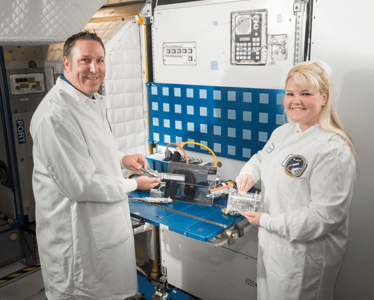NASA runs a full program of biomedical research, with this year seeing space studies on the effect of stem cell-derived cardiomyocytes and drug pill properties, amongst others. Now, the agency has completed the first DNA sequences in space (1), rapidly sequencing one billion base pairs aboard the International Space Station (ISS).
Why sequence in space? Sarah Wallace, project manager of the investigation at the NASA Johnson Space Center, explains, “Right now, we don’t have any abilities to diagnose infectious disease or identify any microbial contaminants that are on the ISS. The crew do take samples, but we have to wait until we get them back to our lab on Earth before we can tell the astronauts what was in the air they’ve been breathing, the water they’ve been drinking, or on surfaces they’ve been touching...”

Aaron Burton and Sarah Wallace with the MinION in the International Space Station mock-up at the Johnson Space Center.
Most conventional sequencing devices are large, power-intensive, and vibration-sensitive – not optimal for transport or operation aboard the ISS. It was the availability of a palm-sized sequencer, the MinION, that made the project feasible, says Aaron Burton, principal investigator of the project at the NASA Johnson Space Center, “A DNA sequencer like the MinION is really versatile, especially for a task like microgravity sequencing, and no doubt there are people out there who can think of even more creative ways to use it.”
As well as the team at the NASA Johnson Space Center, the NASA Ames Research Center, Goddard Space Flight Center, Cornell University, and the University of California San Francisco were all involved with the collaborative project.
“We really hope that this is a capability that transforms space flight research. We will be making the data accessible in the not too distant future, so look out for that...” concludes Wallace.
- NASA, “Biomolecule Sequencer (Biomolecule Sequencer) – 09.21.16”, (2016). Available at: go.nasa.gov/29ptljd. Accessed September 23, 2016.
My fascination with science, gaming, and writing led to my studying biology at university, while simultaneously working as an online games journalist. After university, I travelled across Europe, working on a novel and developing a game, before finding my way to Texere. As Associate Editor, I’m evolving my loves of science and writing, while continuing to pursue my passion for gaming and creative writing in a personal capacity.















